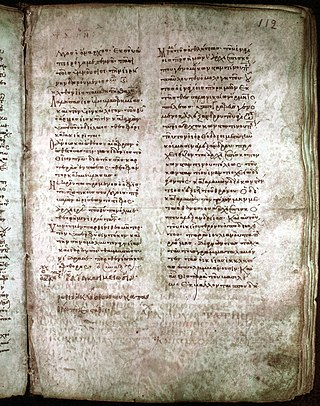Related Research Articles
Uncial 0116, ε 58 (Soden); is a Greek uncial manuscript of the New Testament, dated paleographically to the 8th-century. Formerly it was labelled at first by R, then by Wb (Tischendorf), because letter R was reserved for Codex Nitriensis.
Uncial 0134, ε 84 (Soden), is a Greek uncial manuscript of the New Testament, dated paleographically to the 8th-century. Formerly it was labelled by Wh.
Uncial 0158, α 1039, is a Greek uncial manuscript of the New Testament, dated palaeographically to the 5th century.
Uncial 0159, α 1040, is a Greek uncial manuscript of the New Testament, dated palaeographically to the 6th century.
Uncial 0161, ε 019, is a Greek uncial manuscript of the New Testament, dated paleographically to the 8th century.
Uncial 0174, is a Greek uncial manuscript of the New Testament, dated paleographically to the 5th century.
Uncial 0196, is a Greek uncial manuscript of the New Testament, dated paleographically to the 9th century.
Uncial 0197, is a Greek uncial manuscript of the New Testament, dated paleographically to the 9th-century.

Uncial 0207, is a Greek uncial manuscript of the New Testament, dated paleographically to the 4th-century.

Uncial 0208 is a Greek uncial manuscript of the New Testament, dated paleographically to the 6th century.

Uncial 0209, is a Greek uncial manuscript of the New Testament, dated palaeographically to the 7th-century.
Uncial 0225, is a Greek uncial manuscript of the New Testament. The manuscript paleographically had been assigned to the 6th century. It contains a small parts of the Second Epistle to the Corinthians, on 3 parchment leaves. Written in two columns per page, 21-27 lines per page. It is a palimpsest. Some leaves were added. The upper text is in Pehlevi.
Uncial 0230, is a Greek-Latin uncial manuscript of the New Testament. The manuscript palaeographically has been assigned to the 4th century.

Uncial 0232, is a Greek uncial manuscript of the New Testament. The manuscript palaeographically has been assigned to the 5th or 6th century.
Uncial 0233, is a Greek uncial manuscript of the New Testament. The manuscript paleographically had been assigned to the 8th-century.
Uncial 0240, is a Greek uncial manuscript of the New Testament. Palaeographically it has been assigned to the 5th century.

Uncial 0249, is a Greek uncial manuscript of the New Testament. Paleographically it has been assigned to the 10th century.
Uncial 0277, is a Greek-Coptic uncial manuscript of the New Testament. Palaeographically it has been assigned to the 7th or 8th century.
Uncial 0281, is a Greek uncial manuscript of the New Testament. Palaeographically it has been assigned to the 7th or 8th century.
Lectionary 316 (Gregory-Aland), designated by siglum ℓ316 is a Greek manuscript of the New Testament, on parchment. Palaeographically it has been assigned to the 8th century. The manuscript has survived in a fragmentary condition.
References
- 1 2 3 4 5 Aland, Kurt; Aland, Barbara (1995). The Text of the New Testament: An Introduction to the Critical Editions and to the Theory and Practice of Modern Textual Criticism . Erroll F. Rhodes (trans.). Grand Rapids: William B. Eerdmans Publishing Company. pp. 125–126. ISBN 978-0-8028-4098-1.
- 1 2 3 PSI 13 1296 at the Leuven Database of Ancient Books
- 1 2 3 "Liste Handschriften". Münster: Institute for New Testament Textual Research. Retrieved 18 December 2015.
- ↑ Kurt Aland (1963). Kurzgefasste Liste der griechieschen Handschriften des Neuen Testaments. Berlin: Walter de Gruyter. p. 10.